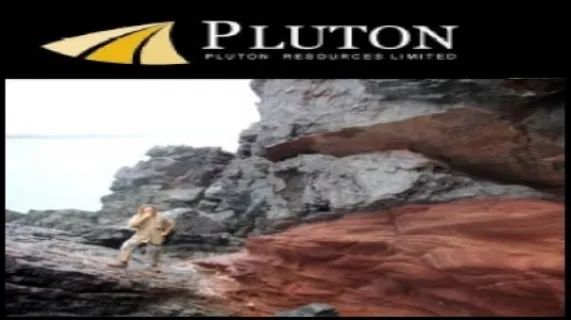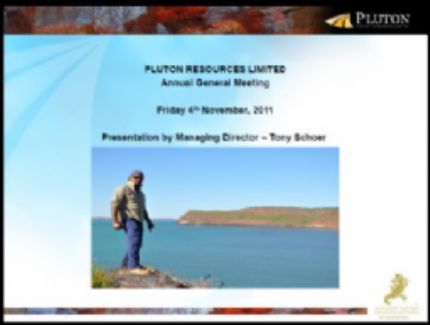
Pluton Resources Limited (ASX:PLV) 3mm Dry Magnetic Separation Testwork Results Produce Positive Economic Benefits
Perth, Nov 3, 2011 AEST (ABN Newswire) - Pluton Resources Limited ( ASX:PLV) are pleased to advise that positive results have been received from additional dry magnetic separation test work completed at a coarse 3mm grind size on drill core composite samples taken from the Hardstaff Peninsula and Isthmus Region.
ASX:PLV) are pleased to advise that positive results have been received from additional dry magnetic separation test work completed at a coarse 3mm grind size on drill core composite samples taken from the Hardstaff Peninsula and Isthmus Region.
The production of a +40% iron pre-concentrate at a 3mm grind size is expected to offer a significant advantage by reducing capital and operating costs, as well as processing benefits.
HIGHLIGHTS
- Results from a total of nineteen (19) composite drill core samples from the Wonganin Sandstone at the Hardstaff Peninsula confirm the head Fe grade required to produce a +40% pre-concentrate is 28% Fe at 3mm grind size. The mass recovery is 52.7%.
- Results from a total of seven (7) composite drill core samples from the Yampi Member at the Hardstaff Peninsula indicate the head Fe grade required to produce a +40% pre-concentrate is 26% Fe at 3mm grind size.
- Results from a total of twelve (12) composite drill core samples from the Yampi Member at the Isthmus Region indicate the head Fe grade required to produce a +40% pre-concentrate is 34% Fe at 3mm grind size.
- The test work results, updated capital and operating costs will be incorporated into the next Ore Reserve update and Stage 2 project valuation.
Comments
Managing Director Tony Schoer said: "The results of the dry magnetic separation test work at a 3mm grind size are significant. They demonstrate that Pluton can produce a pre-concentrate with grades above +40% iron at coarser grind sizes. This has the potential to offer significant cost benefits to the Project in terms of reduced capital and operating expenditure given that grinding to 1mm is not required".
"Also encouraging from this latest round of test results is that the mass recovery for the iron mineralisation in the Wonganin Sandstone averages 52.7%. This compares favorably with the 50% mass recovery value that was used in the economic valuation studies in the Pre-Feasibility Study, announced on 6th June 2011".
"Based on these results, it is our intention to review our process and materials handling designs that were compiled during our Pre-Feasibility Study, in conjunction with our Chinese partners Timeone Holdings Limited. We will therefore incorporate any capital and operating improvements into our current Stage 2 valuation studies and Ore Reserve update for the Project".
Metallurgical Test Work Objectives
Pluton's Pre-Feasibility Study selected the production of a dry pre-concentrate on Irvine Island with final third-party off-island processing to a high grade concentrate as the preferred case for development of the Irvine Island project. This was also considered to offer the best environmental solution at Irvine Island.
Dry magnetic separation tests were previously conducted at 1mm, 2mm and 3mm grind sizes on a representative sample of the Wonganin Sandstone (PLV_8) collected from drill hole 10DDH039 located at the southern end of the Hardstaff Peninsula. The test work results confirmed that the sample could upgrade to a +40% pre-concentrate at a coarser grind size of 2mm and 3mm.
Based on this positive result, Pluton commenced 3mm bench scale variability testing by dry magnetic separation methods on Wonganin Sandstone and Yampi Member drill core composites samples from both the Hardstaff Peninsula and the Isthmus Region.
The test work samples were selected at varying drill hole depths and at a range of iron (Fe) and iron oxide (FeO) grades (including low grade material) to examine the resultant final iron concentrate and impurity grades and mass recoveries.
This information is to be incorporated into the next Ore Reserve determination and Stage 2 valuation studies for the Irvine Island Project.
This announcement details the procedure and test work results for the samples submitted for variability test work at a 3mm grind size by dry magnetic separation methods.
Test Work Samples
Variability testing was completed on a total of thirty-eight (38) diamond drill core composite samples collected from the Irvine Island iron ore deposit as follows:
- Six (6) composite samples collected from within the Wonganin Sandstone at the northern area of the Hardstaff Peninsula.
- Thirteen (13) composite samples collected from within the Wonganin Sandstone at the southern area of the Hardstaff Peninsula.
- Seven (7) composite samples collected from within the Yampi Member at the Hardstaff Peninsula at both the northern and southern areas of the Hardstaff Peninsula.
- Twelve (12) composite samples collected from within the Yampi Member at the Isthmus Region at both the eastern and western areas of the deposit.
All samples were crushed to 3mm with one-quarter (1/4) of the material further crushed to simulate High Pressure Grinding Roll (HPGR) product distributions. The 3mm material was fed to a dry Low Intensity Magnetic Separation (LIMS) machine set at 1000 gauss which collected a magnetic concentrate with the tails being sent to a dry Rare Earth Magnetic Separation (REMS) machine set at 6000 gauss. This collected a magnetic concentrate, a middlings and a tails. All streams were assayed.
Material was weighed initially and all products were weighed, with the difference being dust losses.
Overall dust losses made up approximately 3% of the feed.
The LIMS magnetic concentrate and REMS magnetic concentrate were combined mathematically to give the final product weight recovery and %Fe grade. The REMS middling fraction did not achieve sufficient grade to be included in the calculations.
Results
The results from the dry magnetic separation test work at a 3mm grind size is summarised in Figure 1 (see link at the bottom of the release).
The graph plots the head iron (Fe%) grade vs concentrate iron (Fe%) for the drill core composite samples from the Wonganin Sandstone (blue) and Yampi Member (magenta) from the Hardstaff Peninsula and the Yampi Member (red) from the Isthmus Region.
A total of nineteen (19) samples were collected from the Wonganin Sandstone at the Hardstaff Peninsula. Six (6) were collected from the northern area and a total of thirteen (13) were collected from the southern area. Head iron (Fe%) ranged from 12.5 Fe% to 30.8 Fe% and iron oxide (FeO) ranged from 0.0 FeO% to 8.7 FeO%.
The graph indicates that for the Wonganin Sandstone, a head iron (Fe%) grade of 28% is required to produce a +40% iron pre-concentrate.
A total of seven (7) samples were collected from the Yampi Member at the Hardstaff Peninsula. Head iron (Fe%) ranged from 22.0 Fe% to 51.2 Fe% and iron oxide (FeO) ranged from 0.5 FeO% to 12.4 FeO%. The graph indicates that for the Yampi Member at the Hardstaff Peninsula, a head iron (Fe%) grade of 26% is required to produce a +40% iron pre-concentrate.
A total of twelve (12) samples were collected from the Yampi Member at the Isthmus Region. Head iron (Fe%) ranged from 17.5 Fe% to 50.6 Fe% and iron oxide (FeO) ranged from 0.7 FeO% to 10.3 FeO%. The graph indicates that for the Yampi Member at the Isthmus Region, a head iron (Fe%) grade of 34% is required to produce a +40% iron pre-concentrate.
For the complete Pluton Resources announcement including figures and tables, please view the following link:
http://media.abnnewswire.net/media/en/docs/ASX-PLV-364141.pdf
Contact
Tony Schoer
Managing Director
Tel: +61-411-232-711
Pluton Resources Limited
| ||
|







